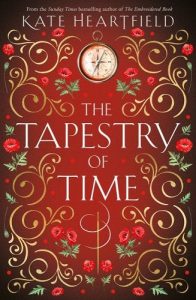The Tapestry of Time by Kate Heartfield: Review by Gary K. Wolfe
 The Tapestry of Time, Kate Heartfield (Harper Voyager 978-0-00-856781-1, £16.99, 384pp, hc) October 2024.
The Tapestry of Time, Kate Heartfield (Harper Voyager 978-0-00-856781-1, £16.99, 384pp, hc) October 2024.
Sometimes a trope seems so familiar that it begins to feel like a tire that’s lost its tread, even though it’s still fun to drive on. The Nazi preoccupation with occult powers has itself been a preoccupation for writers from all over the spectrum – horror (F. Paul Wilson, Robert McCammon), fantasy (Katherine Kurtz, Ian Tregillis), SF (Charles Stross, China Miéville), even aging blockbusters like Raiders of the Lost Ark. The challenge Kate Heartfield takes up in The Tapestry of Time is to find ways of giving new traction to the old bald tire, and her strategy is largely to relegate it to a subplot in a thriller whose real focus is elsewhere – and which draws on the even older tradition of clairvoyance tales. These have their own fascinating history of migrating from genre to genre. Once mostly a subset of supernatural fiction with Victorian-era examples such as George MacDonald’s The Portent, they became a popular SF theme for a while with ‘‘psionic’’ and precognition tales from Alfred Bester to Philip K. Dick, then became a staple of horror with the work of Stephen King (what else do titles like The Shining mean?) and others. Heartfield’s use of clairvoyance, though, leans not toward horror or SF, but toward that older fantasy tradition of certain families gifted with what was once called second sight, and it’s that family focus that gives the novel its most impressive texture.
There are other traditions at work as well in The Tapestry of Time, most notably from historical fiction. Heartfield’s meticulously researched historical fantasy has taken us from medieval Bruges (The Chatelaine, revised from her earlier Armed in her Fashion), the Habsburg Empire (The Embroidered Book), and sixth-century Burgundy (The Valkyrie) – each of which earned Canada’s distinguished Aurora Award for best novel. She also skillfully weaves in elements of espionage fiction, along with some real-world cryptohistorical mysteries surrounding the Bayeux Tapestry, the massive medieval artwork apparently depicting the Norman invasion of England. In particular, Heartfield makes effective thematic use of the image of a mysterious woman who appears in the tapestry, Aelfgyva, a figure who remains largely inexplicable to historians. If all that sounds like a pretty full plate with all sorts of room for dumps and digressions, the result instead may be Heartfield’s most tightly plotted and suspenseful novel to date.
Like Liz Williams’s recent Fallow Sisters novels (with which it shares little else in common), its focus is on four British sisters who share a connection to the supernatural world, in this case varying degrees of second sight – the capacity to see remote people or events, and possibly future events as well. It’s a skill which they don’t quite believe in despite the repeated insistence of their Aunt Kathleen that the family is special. They also share a connection to art history, and in particular to the Bayeux Tapestry, since their father has made interpreting it his life’s work – though his reputation has suffered because of what is widely regarded as his crackpot theory that the tapestry actually predated the Norman invasion. This has resulted in some family estrangement, especially with Kit, who works as a research assistant in the Louvre and whose lover is an archeological assistant named Evelyn. But as the novel begins on the day after D-Day, Kit faces a more immediate family concern: She learns that her sister Ivy, the youngest of the four, has been missing since parachuting into France on a special mission to connect with the Resistance. Even more unnerving, Kit repeatedly seems to catch glimpses of Ivy, and eventually sets out with her friend Max, a British spy, to try to find her. Meanwhile, the other two Sharp sisters, Helen and Rose, remain in England.
The middle part of the novel shifts mostly to Ivy’s point of view, detailing events leading up to that parachute drop, including Ivy’s recruitment and training by a special program within the British government’s Special Operations Executive to maximize her clairvoyant powers. Ivy discovers that contact with even a tiny fragment of the tapestry seems to enhance her power. Needless to say, those snoopy Nazis are also aware of this effect, and Himmler himself wants the tapestry stolen and taken to Germany. This is essentially the espionage-thriller section of the novel, and it’s a fast-moving sequence of captures and escapes, alliances, betrayals, and cliffhangers – all while putting on hold the central question of whether Kit will be able to use her own clairvoyant skills to track down and rescue Ivy. The depiction of rural occupied France in the months before and after D-Day, with its ruined villages and Nazi brutalities, is harrowing in ways that lend historical weight to the more baroque schemes involving the tapestry, which inevitably becomes a kind of McGuffin, even as its provenance – and especially those oddball-but-maybe-possible theories of the sisters’ father – becomes a narrative thread all its own. Historical artifacts with Dark Secrets may have become something of a cliché lately, from Dan Brown novels to National Treasure movies, but with The Tapestry of Time, a solid art-historical thriller for grownups, Heartfield could teach them all a few lessons about actual research, actual characters, and – with its clear and efficient prose–even actual sentences.
Interested in this title? Your purchase through the links below brings us a small amount of affiliate income and helps us keep doing all the reviews you love to read!
Gary K. Wolfe is Emeritus Professor of Humanities at Roosevelt University and a reviewer for Locus magazine since 1991. His reviews have been collected in Soundings (BSFA Award 2006; Hugo nominee), Bearings (Hugo nominee 2011), and Sightings (2011), and his Evaporating Genres: Essays on Fantastic Literature (Wesleyan) received the Locus Award in 2012. Earlier books include The Known and the Unknown: The Iconography of Science Fiction (Eaton Award, 1981), Harlan Ellison: The Edge of Forever (with Ellen Weil, 2002), and David Lindsay (1982). For the Library of America, he edited American Science Fiction: Nine Classic Novels of the 1950s in 2012, and a similar set for the 1960s. He has received the Pilgrim Award from the Science Fiction Research Association, the Distinguished Scholarship Award from the International Association for the Fantastic in the Arts, and a Special World Fantasy Award for criticism. His 24-lecture series How Great Science Fiction Works appeared from The Great Courses in 2016. He has received six Hugo nominations, two for his reviews collections and four for The Coode Street Podcast, which he has co-hosted with Jonathan Strahan for more than 300 episodes. He lives in Chicago.
This review and more like it in the November 2024 issue of Locus.
 While you are here, please take a moment to support Locus with a one-time or recurring donation. We rely on reader donations to keep the magazine and site going, and would like to keep the site paywall free, but WE NEED YOUR FINANCIAL SUPPORT to continue quality coverage of the science fiction and fantasy field.
While you are here, please take a moment to support Locus with a one-time or recurring donation. We rely on reader donations to keep the magazine and site going, and would like to keep the site paywall free, but WE NEED YOUR FINANCIAL SUPPORT to continue quality coverage of the science fiction and fantasy field.
©Locus Magazine. Copyrighted material may not be republished without permission of LSFF.







